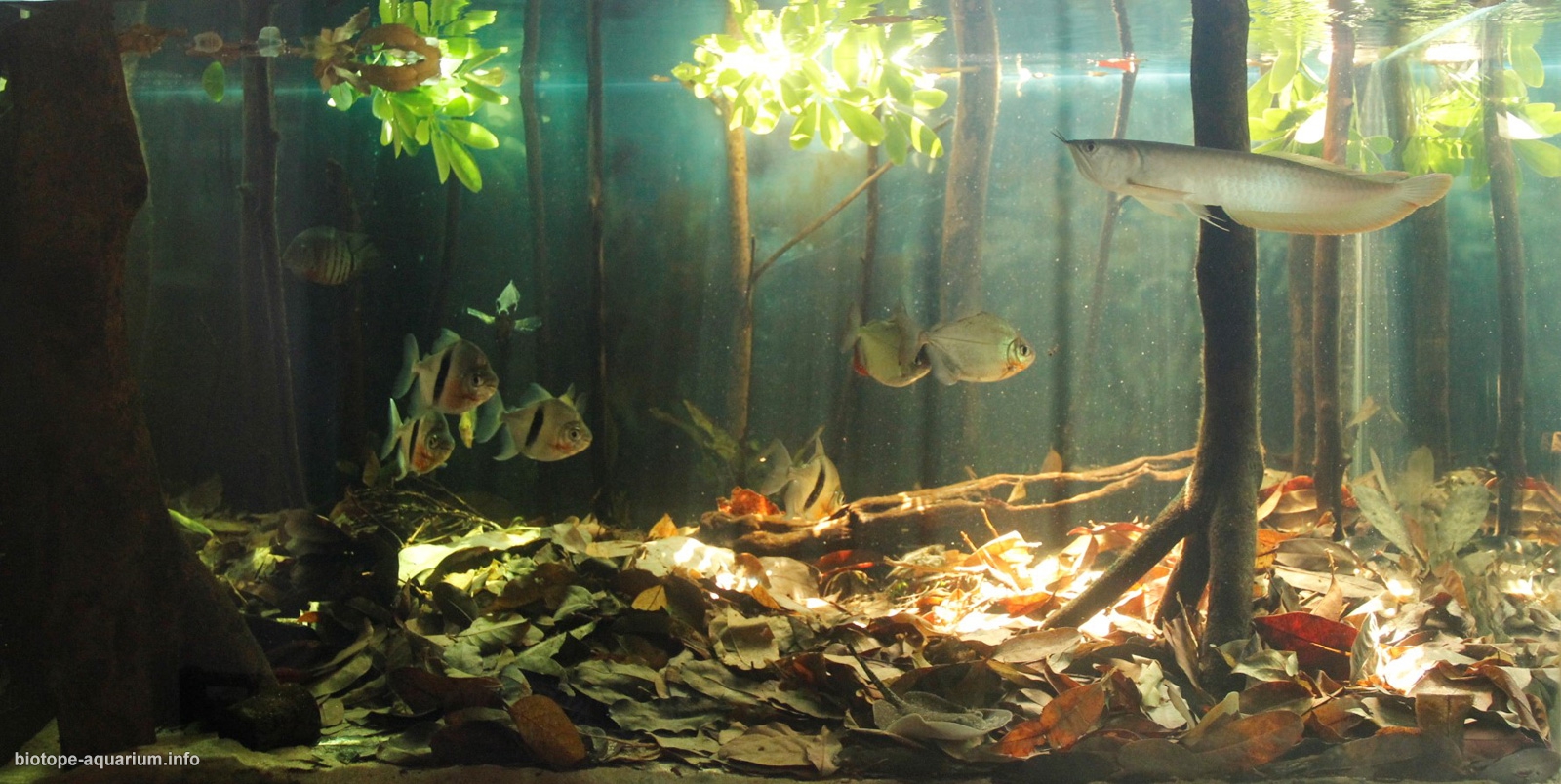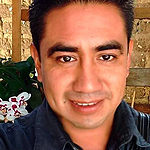Flooded forest of middle Amazon basins in Brazil
44th place in Biotope Aquarium Design Contest 2018
![]() China. Han-Jun Cai
China. Han-Jun Cai

Volume: 840 L
Dimensions: 150x80x70 cm
List of fishes: Heros severus, Osteoglossum bicirrhosum, Metynnis hypsauchen, Metynnis lippincottianus, Myloplus schomburgkii, Potamotrygon motoro
List of plants: Anubias hastifolia, Schefflera octophylla (only for decorations here)
Description of decorations: Substrate comprise mainly white and fine sand with some river sand. Straight and dry tree trunks and branch with different size used here for simulation of the trees in the flooded forest. Some driftwoods and branch and lots of mixed dry leaves are used as the substrate too. Anubias hastifolia planted at the bottom and the Schefflera octophylla placed up above water both are simulation of the live plant leaves in the flooded forest.
Description of equipment: A 120L upper sump driven by a pump of EHEIM compact+ 5000L. A heater of EHEIM 300W. Lamp is T5HO 4 tubes with wihte and some blue light,and it could be turned on 3-4 hours in the night per day.
Water parameters: Temperature is 27℃, colour is a little beige, pH is 7.0.
INFORMATION ABOUT BIOTOPE
Description of the area surrounding the biotope: The Amazon River floods twice a year as the rivers, and then swell and then exceed their banks after dramatic amounts of seasonal rainfall in these watersheds. These forests host combinations of terrestrial and aquatic components which dominate during different seasons of the year. For instance, trees and aquatic herbaceous vegetation rest on the ground during the low water season. Over time (from decades to millennia) these river courses meander across the floodplain, resulting in ever-changing geomorphology and heterogeneous landscape with a diversity of elements such as oxbow lakes, levees, meander swales, and point bars. Lateral erosion and deposition on the riverbanks occur with every flood, resulting in a vast number of ephemeral fluvial islands and extensive bands of primary successional forest.
Description of the underwater landscape of the biotope: The river water, heavily laden with sediments and thus called whitewater, floods the surrounding forest under 6 to 7 m for periods up to ten months each year, affecting a swath of land up to 20 km wide. The dynamic geomorphology is reflected in the diversity of vegetation types. And it is mainly cover by fallen leaves and woods.
Description of the parameters of the habitat: Annual precipitation in this region ranges from 2,400 to 3,000 mm, and the average annual temperature is 26° C, with little seasonal variation.
List of fishes and invertebrates occurring in the nature biotope: Aquatic mammals include the Amazon River dolphins (Inia geoffrensis, pink, and Sotalia fluviatilis, grey) and vulnerable manatees (Trichechus inunguis). Very large fish live in these whitewater rivers, and during the flood season they roam through the flooded forest eating and dispersing fruits from the floodplain trees. These fish include the pacu (Metynnis and Mylossoma), tambaqui (Colossoma macropomum), pirarucu (Arapaima gigas), sardinha (Triportheus angulatus), and the smaller pirana (Serrasalmus spp.), a carnivorous characin. Many beautiful aquarium fish come from these rivers and blackwater tributaries and lakes in this region. These include the angelfish (Pterophyllum scalare), the discus fish (Symphsodon aequifasciata sp.), hundreds of cichlids such as in the genus Cichlasoma, assorted characins (family Anostomidae) such as tetras in the genera Hemigrammus and Hyphessobrycon and the famous neon tetra (Paracheirodon innesi), and many small catfish (families Aspredinidae, Corydoradinae, Doradidae and Loricariidae).
List of plants found in the nature biotope: The region is characterized by an evergreen tropical forest with a complex and heterogeneous vertical structure. Because of the river action, these forests are found in numerous seral stages and with topographically or edaphically distinct floristics. The youngest vegetation is dominated by the grasses Gynerium sagittatum, Paspalum repens, and Echinocloa polystachya. This is followed by woody shrubs, such as Adenaria floribunda, Alchornea castanaefolia, and Salix martiana, then by early successional trees, such as Annona hypoglauca, Astrocaryum jauari, and Cecropia latiloba. Late successional forests, characterized by the tree genera Chorisia, Eschweilera, Hura, Spondias, and Virola, are found on ancient alluvial terraces. Extensive stands of the economically important buriti palm (Mauritia flexuosa) and Jessenia batuaua are characteristic in this region as well in permanently inundated areas. The waters edge is sometimes dominated by shrubs of the camu-camu fruit (Myrciaria dubia) that not only survive the long flood season, but seem to flourish. A strong component of monocots in the Heliconiaceae, Zingiberaceae, and Marantaceae dominate parts of the understory, along with palms and epiphytes. Trees that stand out in mature forests are Calycophyllum spruceanum, Ceiba samauma, Inga sp., Cedrela oderata, Copaifera reticulata, and Phytelephas macrocarpa. Palms such as Sheelea. Guazuma rosea, of subandine origin, are common on the Upper Purus, and Piptadenia pteroclada is common along the Amazon. Stands characterized by Parkia inundabilis, Septotheca tessmannii, Coumarouna micrantha, Ceiba burchellii, Ochroma lagopus, Manilkara inundata, and Iryanthera tessmannii are abundant.
Threats to the ecology: Anthropogenic-induced habitat loss is the main threat to the flora and fauna in this region. Contamination of rivers and fish by gold mining activities, and heavy sedimentation resulting from forest destruction, such as logging, threaten the várzea biota and habitat. Mahogany (Swietenia macrophylla) and several other timber species have been locally eliminated in some areas, along with tapir and several primates. Commercial fishing and river contamination threatens populations of some fish and aquatic mammals. Ranchers clear and burn large patches of floodplain forests to encourage native grasses for livestock grazing, and in the process destroy important habitat and food for fish.
Sources of information:
Comments of the members of the jury of Biotope Aquarium Design Contest 2018

This aquarium has really natural looking. You’ve imitated very well to the natural habitat, well done. You used big pieces of woods on the front side and small pieces on the back one. Therefore this aquarium looks deeper. Volume may be enough for now but you will need a bigger aquarium when your fishes grow. Good job, congrats.

When you look at this entry, it takes you to the nature biotope in terms of appearance. The light effect complements the design very well. At the bottom, as a suggestion, I would add detritus in order to have even more naturalness. Congratulations!

This is different. Interesting to see. But this tank is not big enough to house these species in the long term.
